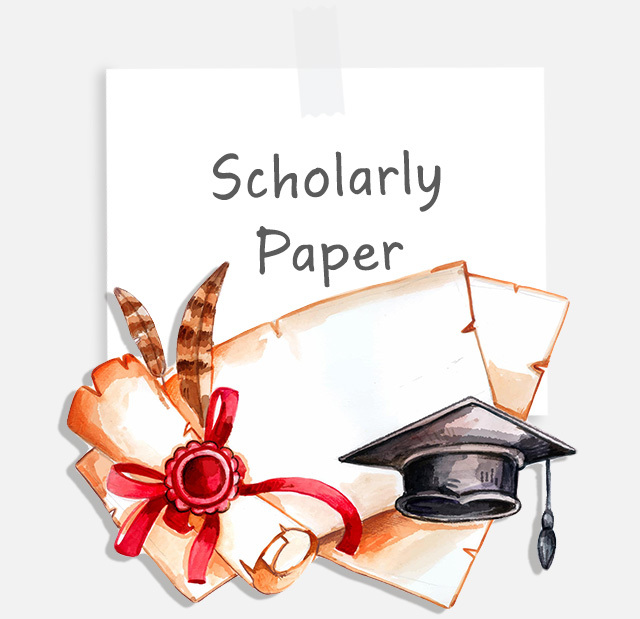
What is a Scholarly Paper?
A scholarly paper, aka scientific paper/research or scholarly article, is a piece of academic writing that studies a specific topic and is published in academic journals. As the name suggests, it’s the type of writing researchers, scholars, and all those people from laboratories wearing white coats do.
It sounds a bit scary, doesn’t it? But don’t worry because writing a scholarly paper won’t be as intimidating as it sounds once you read our guide. Now, check what components this paper contains and how to start writing it.
Scholarly Paper Outline
What is a scholarly paper outline? It’s a skeleton of your research that consists of three elements – introduction, body, and conclusion. At the same time, a scholarly paper format contains more sections. It breaks down these three elements into the following subsections:
- Abstract.
- Introduction.
- Materials and methods – applicable to scientific experiments.
- Results.
- Tables and figures.
- Discussion.
- Conclusions.
- References.
Now, which one of these paragraphs is the introduction, body, and conclusion? Abstract and Introduction should be your introductory paragraphs.
Methods and Results will comprise the body of your scholarly paper. The rest of the sections will summarize and conclude your scientific findings.
You may come up with whatever titles you are comfortable with for these eight sections or add more subsections for better readability. Just make sure the structure of your paper comes in line with these sections.
How to Choose a Topic for a Scholarly Paper?
You may sit tight and spend an hour just thinking about what topic you want to pick for your scholarly paper. If it’s your case, consult your tutor. It doesn’t hurt to ask them.
By doing so, you will show that you want to craft an A+ paper genuinely because you care about the topic. It will also help your tutor feel valued because they’ve made their students interested.
If it doesn’t help, we have a few more topic selection tips that do the trick! Keep reading to check them out.
Aim for Feasible Research
Feasible research means you can fit it into the word count of your scholarly paper. Don’t opt for broad, generalized topics that require decades of research.
For instance, you don’t want to write a research paper about cats. Even at this point, you have probably thought: “What cats?” Yet, it is an excellent question you can use to scale down your topic to something manageable. In this case, a good subject will be something like “measuring the frequency range of sounds cats make.”
Make Sure You’re Not Reinventing the Wheel
Selecting the topic for your paper requires initial research because you would want to conduct an original experiment. So, once you come up with the topic, make sure you’re not going to repeat someone’s experiment step by step or analyze the same thing.
Select Topics Available for Research
Students often overlook the fact that their topics may not be covered well enough. Eventually, they get stuck somewhere amid their paper’s body, unable to go further because nothing is left to write about. Think “magnitude of tectonic activity on Kepler 452-B.” You will hardly find sufficient research on this topic. Consequently, avoid subjects that scientists haven’t researched enough.
Get Inspiration from Google
Lastly, you can search for several scholarly paper topics on the Internet and then dig deeper into one you like. It will help you break the writer’s block as you can always stumble upon a worthy idea on the topic listings.
How to Write a Scholarly Paper Step by Step?
While structurally your paper starts with the abstract, you should begin from a different angle. So check how to start and finish your scholarly essay like a pro below.
How to Start a Scholarly Paper?
You want to start your scholarly article with research. Find as many related studies as possible. Make sure you can easily access them while writing your paper. For instance, save links to the studies in Excel or Google Spreadsheets.
By reading studies, web articles, forums, etc., you will figure out the points to uncover within your research paper. Once you get a clearer picture of your topic, you should define the main idea of your essay using a thesis statement.
How to Come Up with the Thesis Statement for Your Scholarly Paper
Let’s assume you will write about the vocal range of cats. Your thesis statement should be clear, concise, and refer to the point of your research.
It should read like this: “This paper classifies the vocal range of 40 feline species by frequency.” As you see, this thesis statement is super-clear, and it explains what kind of research you conducted.
By the way, scholars published similar research in the Journal of Veterinary Science, which is an international, peer-reviewed publication. So feel free to check their thesis statement:
How to End a Scholarly Paper?
While both the discussion and conclusion parts of the research paper are concluding paragraphs, researchers may use them differently.
They break the concluding parts of their studies into Discussion and Conclusion. It’s because summarizing the findings of voluminous studies takes a lot of space, and separating the summaries helps achieve higher readability.
In the discussion part, you can condense your findings and answer the primary questions of your research. Let’s recall cat purrs once again. You will have to write the discussion section following this direction:
“The paper discovered that cat species produce X number of vocal signals – meows, howls, gurgles, hisses, growls, purrs, etc. Domestic cats’ howls are 600-700 Hz, while larger cats produce the same signals at lower frequencies.”
The conclusion part summarizes discussions, provides context for further research, and wraps up the whole paper. Sounds a bit unclear? Don’t worry, since now you will learn the anatomy of each section of the scholarly paper.
How to Structure a Scholarly Paper?
Scholarly Paper Abstract
An abstract is a summary of your paper as a whole. It’s not merely an introduction, although it counts as an introductory part of your paper.
To write a standardized abstract, you should treat it as a standalone mini version of your paper. Given that, this piece should include these mini sections:
- Introduction. A couple of sentences that provide background for the discussed topic.
- Body. A summary of the main findings.
- Conclusion. One or two wrapping sentences to show the significance of the research and its implications.
Scholarly Paper Introduction
The introduction of the scholarly research paper should consist of the following elements:
Background Information
Start your introduction with the background information that introduces the topic of your research. Let’s assume your topic is a novel treatment of cancer. To deliver context to your topic, show its significance and relevance by adding credible cancer statistics.
Previous Research
The introduction of your scholarly essay or paper should also mention previous research conducted on the described topic. It will also add weight and value to your work, as it tells the reader that the subject receives plenty of scholarly attention.
Thesis Statement
Once you explain the background of your topic to your readers, it’s high time to write about procedures and experiments you did within your research paper. That is where your thesis statement comes into place.
Scholarly Paper Body
Scholars use the TEECL approach when writing content for their studies. Here is what TEECL stands for:
- Topic sentence. It’s the main idea of your paragraph. For example: “insects are small.”
- Explanation. It’s time to explain why your topic sentence is relevant. “Insects are small because they utilize diffusion to supply oxygen to their cells.”
- Evidence. “Instead of lungs, insects have small tubes inside their bellies meant to suck oxygen through diffusion.”
- Comment. In this part, you explain why your explanations and arguments are valid. “Diffusion doesn’t work well on a bigger scale. If we make an insect two times bigger, the tubes will be too long to provide enough oxygen to the larger body.”
- Link. It’s a small conclusion that also refers your reader to further body paragraphs. “Insects are small because their breathing systems don’t allow them to grow any larger. But ancient insects are a whole different story.”
Scholarly Paper Conclusion
The research paper conclusion also has several elements:
- The restated and reevaluated thesis statement. It means you should not only rephrase the thesis statement but also look at the problem from a new angle, considering all the research you have done.
- Summary of the main findings.
- The final word. You have to explain why your research matters, why it’s helpful for the subject you’re studying, and how other researchers can benefit from your study.
Scholarly Papers Examples
Check these scholarly papers examples to see how their sections look like together:
- A study on CRISPR-Cas.
- A research paper about genes.
- An article about fibromyalgia.
Scholarly Papers Writing Tips
Check these three pro tips for writing top-notch scholarly essays and papers to make sure your work brings you the top grade:
Keep in Mind the Academic Language Rules
Here is general advice for getting your writing to the academic standard:
- Don’t use contractions – don’t, isn’t, won’t, etc.
- Exclude colloquial language – slang, phrasal verbs, and proverbs.
- Exclude unsupported claims – always provide evidence for your arguments.
- Avoid personal pronouns.
Don’t Complicate Your Academic Language
The academic language implies that you use unbiased and concise phrasing. But students and experienced researchers alike sometimes try to sound smarter by complicating their writing pieces with:
Excessive nominalizations
“The unnecessary complication of the language is achieved through the frequent usage of nominalizations.” This statement sounds scientific, but it’s barely readable. So use more active verbs instead of derivative nouns. For instance: “Nominalizations make the language unnecessarily complicated.”
Too Much Passive Voice
“The scholarly paper on cat vocalization is meant to demonstrate that the range of feline vocal signals is produced at the frequency of 600-700 Hz.” You can rephrase this sentence with this one to simplify it: “The scholarly paper on cat vocalization demonstrates that cats vocalize at frequencies between 600 Hz and 700 Hz.”
Filler words
“The intention to write a scholarly paper led me to the engagement in this helpful article.” You can easily replace this passage with a much simpler and shorter alternative: “I read this article because I wanted to get an A for my scholarly paper.”
Writing Tools Are a Must
Grammar checkers, readability enhancers, and citation machines are an absolute necessity for academics, students, and independent researchers.
These tools will help you save two or even four hours of editing on average since they quickly spot and even autocorrect most typos and grammatical errors. So, you can use these three tools to submit professional scholarly papers:
- Grammarly. It’s the number one grammar checker used by 30 million people.
- Hemingway App. It’s a helpful tool for improving readability.
- Citation Machine. This tool will help you create bibliography pages in a few clicks.
Writing Help by Handmadewriting
Now, you can write a high-class scholarly paper. You will do it much faster now that you’ve learned what scholarly paper outline to use, how to select the topic, and how to start writing this piece. Yet, it might still be a struggle though. Thus, if you have no time for this task or English is your second language, you can always ask professional academic essay writers at Handmadewriting for help.






